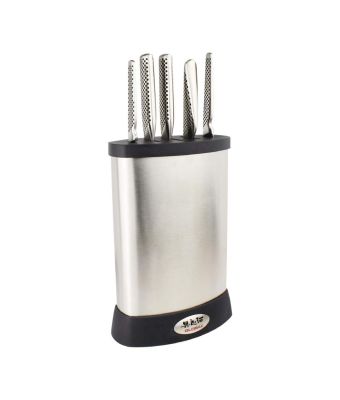Common Knife Techniques

You could have the best knives in the world, but you won’t be getting the most out of them unless you know how to use them properly. If you’re not too confident with your kitchen knives, try out these techniques to help you be a better cook and use your knives more efficiently.
In this guide:
- The Intro
- Holding Your Knife
- Chopping & Slicing
- Dicing
- Mincing
- Chiffonade
- Julienning
Holding Your Knife Correctly
The first and most basic step towards using a knife properly is to make sure that you are holding it correctly. Not only will this make you more efficient, but it will also keep your fingers and hands safe.
Start off by gripping the knife handle with your thumb lying straight so the tip of your thumb is pressed against the flat part of the blade, with your index finger on the other side of the blade, curved round so it sits on the other side of the flat part of the blade but points back towards you.
It’s also important to think about what you’re doing with your other hand though, as this provides important support. With your non-cutting hand, make a claw rather than letting your hand lay flat. This means that the blade will hit up against your knuckles rather than putting your fingertips in danger of being cut.
While these are good tips to follow, ultimately, the best way to hold your knife is in a way that feels safest to you. Try to keep a relaxed grip on the knife while using it and let the blade do the work and always make sure that each finger is positioned so that it’s almost impossible to cut them.
Chopping & Slicing
Chopping is one of the most basic kitchen skills you need to learn, so it’s important to perfect.
Instead of chopping straight down with your knife, try using a slight rocking motion, starting from the tip. This will help you to get a more even cut.
Depending on what you’re slicing, your choice of knife is going to be important. For example, a serrated knife is best for chopping tomatoes, but smaller knives will be better for the likes of fruit and veg.
Instead of using quick downward strokes, it’s best to use a more controlled back and forth sawing type motion when chopping.
Dicing
One of the best starting points, when you are learning knife skills, is dicing onions. There are different ways to do this, but we’ve found the most effective, safe and efficient way is to start by cutting the top and bottom off before chopping it in half from top to bottom.
Once you have removed all of the skin, place the onion halves with their flat side facing down and the flat edges pointing left and right.
You can now make slices parallel to the flat ends of the onion. Next, keeping the slice together, turn them so they are sat on one of the smaller flat sides with the long flat side facing out to the side. Now start slicing as you did before and you will end up with small cubes of onion.
Mincing
Garlic is a key ingredient in home cooking, so knowing how to mince it is an important skill. Start by removing the root from the clove, then use the flat side of your chef’s knife to crush it.
This will make it a lot easier to get rid of the skin. Now you can start using a rocking motion with your knife to chop the garlic.
Repeat this motion, bringing the chunks of garlic back to the centre of the chopping board until you are satisfied with your minced garlic.
Chiffonade
A knife skill that you may not have heard of before, chiffonade refers to cutting leafy greens and herbs into long, thin strips (it translates from French to little ribbons) and you’re most likely to use this one when slicing herbs to be used for garnishing.
Start out by stacking up your leaves into a pile and tightly rolling them up into something resembling a cigar shape.
Once you’ve done this, you want to make very thin slices right across the pile, which should give you those nice small ribbons.
Julienning
Another slightly more advanced cutting technique, Julienning also refers to cutting into long thin strips, but is more commonly used with carrots and celery, and leaves you with small matchstick-shaped pieces.
You start out by cutting your ingredient into small segments (about two inches) and cutting off a small part to create a flat base.
Place the ingredient face down on this flat edge and make small, equal slices, which you’ll then stack up on top of each other and slice down again, to create your equally sized matchsticks.
These are just some of the basic knife skills that you should look to perfect if you want to make your meal prep more efficient.
Remember to always keep your knives sharp and always make sure that you’re thinking about safe.

